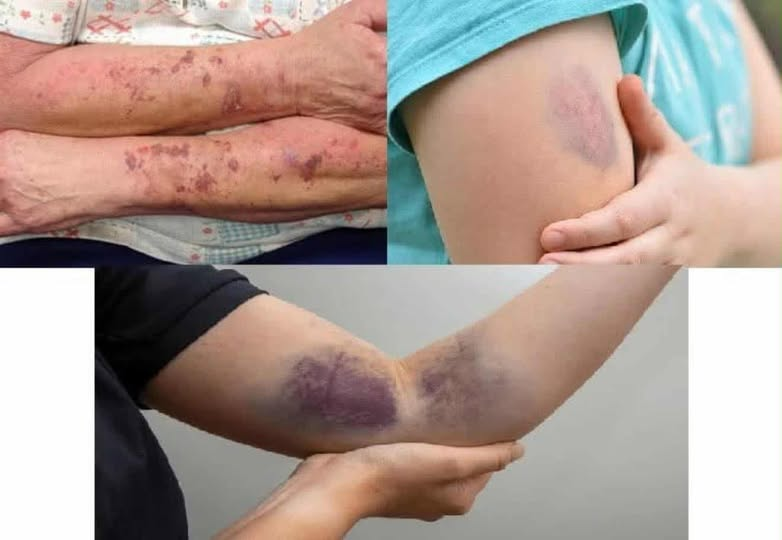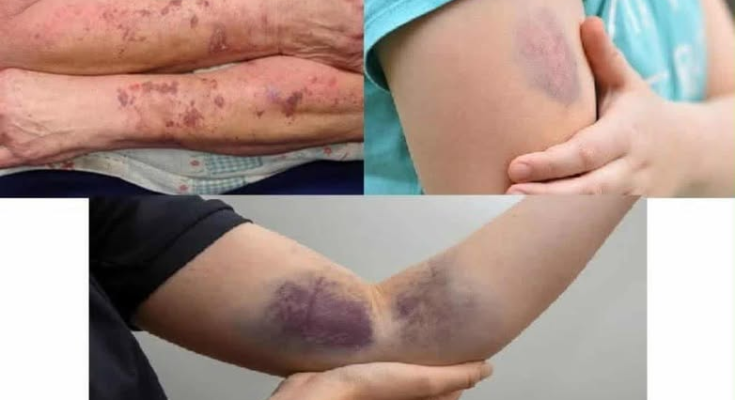
Have you ever noticed a dark purple, blue, or green mark on your skin and wondered, “Where did that come from?” Bruising is a natural occurrence that happens to everyone at some point, but when bruises appear often—or without a clear cause—it can spark concern. Many people brush them off as a cosmetic nuisance, but in reality, bruises can sometimes act as important indicators of what’s going on inside your body.
This article takes a deep dive into the subject of unexpected bruising. We will explore the science behind bruises, the common and not-so-common causes, and what patterns you should watch out for. You’ll also learn about nutrition, lifestyle habits, preventive strategies, and when it’s time to seek medical advice. By the end, you’ll not only understand why bruises happen, but also how to take steps toward healthier skin and stronger blood vessels.
What Exactly Is a Bruise?
A bruise, also called a contusion, occurs when tiny blood vessels under the skin—called capillaries—are damaged by some form of impact or pressure. This damage causes blood to leak into the surrounding tissue, leaving behind that familiar discoloration.
At first, a bruise may appear reddish or purple. Over time, as the body breaks down the trapped blood, the color shifts to blue, green, yellow, or brown before eventually fading away. This process can take days or even weeks depending on the severity of the injury, the location on the body, and the individual’s overall health.
Common Causes of Bruising
1. Everyday Physical Trauma
The most straightforward reason bruises appear is physical impact. Bumping into a table, knocking your shin against a chair, or accidentally dropping something heavy on your foot are classic examples. In most cases, these bruises are harmless and heal within one to two weeks.
2. Age-Related Skin Changes
As people get older, the skin becomes thinner and loses some of its protective fat layer. Blood vessels also become more fragile. This explains why older adults often find themselves with more bruises, even from minor bumps they may not remember.
3. Medications and Supplements
Certain drugs and even some herbal supplements can make bruising more likely. For example:
- Blood-thinning medications (such as aspirin or warfarin) reduce clotting ability.
- Corticosteroids, used for conditions like asthma or arthritis, weaken blood vessel walls.
- Supplements like fish oil or ginkgo biloba can also have mild blood-thinning effects.
If you take these regularly, it’s important to be aware of the possible side effects and to discuss concerns with a healthcare professional.
4. Nutritional Deficiencies
Your diet plays a surprisingly large role in how easily you bruise. Deficiencies in the following nutrients are often linked to skin and blood vessel weakness:
- Vitamin C – Supports collagen production, essential for strong vessel walls.
- Vitamin K – Key for blood clotting and wound healing.
- Vitamin B12 and Folate – Crucial for red blood cell formation and overall skin health.
- Protein – Helps repair tissues and aids recovery.
Eating a diet rich in fruits, vegetables, lean proteins, and whole grains provides the body with what it needs to heal and protect itself.
5. Underlying Health Conditions
While most bruises are harmless, sometimes they can signal an underlying medical issue. Conditions that may contribute to frequent bruising include:
- Blood disorders such as anemia or low platelet counts
- Liver disease, which affects clotting factors
- Kidney disorders, which can impact circulation and fluid balance
- Certain types of cancer, including leukemia, which disrupt blood cell production
These are rare compared to everyday causes, but unexplained bruising should never be ignored.
Normal vs. Concerning Bruises
How do you tell the difference between a typical bruise and one that requires medical attention?
Normal Bruising:
- Appears after a bump, fall, or noticeable injury
- Small to medium in size
- Changes color gradually and fades within two weeks
- Usually painless or mildly sore
Concerning Bruising:
- Appears spontaneously without injury
- Large, painful, or swelling occurs in the area
- Found in unusual places like the torso, back, or face
- Accompanied by other symptoms such as fatigue, nosebleeds, or frequent infections
If you notice bruises that fit into the second category, consulting a doctor is the best step forward.
Tips for Preventing Bruises
Even if you’re someone who bruises easily, there are steps you can take to minimize the risk:
- Protective Clothing – Wear padding or long sleeves when engaging in physical activities that could cause bumps or scrapes.
- Nutrient-Rich Diet – Include vitamin-rich foods like citrus fruits (Vitamin C), leafy greens (Vitamin K), and lean proteins.
- Exercise Safely – Strength training and balance exercises reduce falls and accidents.
- Apply Ice Quickly – If you do bruise, an ice pack applied within the first 15 minutes can reduce swelling.
- Elevate the Area – Keeping the bruised area raised helps prevent blood from pooling.
- Limit Alcohol and Smoking – Both can affect circulation and clotting.
The Role of Age and Hormones
Hormonal changes, especially in women after menopause, also contribute to increased bruising. Declining estrogen levels affect skin elasticity and blood vessel strength, making bruises more frequent and noticeable.
Being aware of these changes can help older adults take extra precautions, such as wearing protective clothing and maintaining strong nutrition habits.
The Emotional Side of Bruising
Bruises aren’t just a physical issue—they can also have an emotional and psychological impact. People who bruise easily may feel self-conscious, especially if marks appear on visible areas like arms or legs. This can lead to stress, embarrassment, or even social withdrawal.
Ways to cope include:
- Using clothing or makeup to cover visible bruises if desired
- Practicing self-care to maintain confidence
- Talking with supportive friends, family, or counselors if anxiety becomes overwhelming
Taking care of your mental health is just as important as addressing the physical cause.
When to See a Doctor
Seek professional medical advice if you notice:
- Frequent bruises without clear cause
- Bruises that last longer than two weeks
- Bruises accompanied by fever, fatigue, or unexplained weight loss
- Unusual bleeding, such as from gums or nose
- Sudden changes in skin texture or color
Doctors may recommend blood tests, liver function tests, or imaging scans depending on your symptoms. Catching health issues early can make treatment more effective.
Natural Ways to Support Healing
Beyond medical advice, some natural remedies can support bruise healing:
- Arnica Gel or Cream – A plant-based remedy often used for bruises and swelling
- Aloe Vera – Known for soothing skin and reducing inflammation
- Cold Compresses – Help with pain and swelling immediately after an injury
- Warm Compresses – Improve circulation and speed recovery after the first 48 hours
Always check with a doctor before combining natural remedies with prescription medications.
Final Takeaways
- Bruising is common and often harmless, especially after a bump or fall.
- Age, medications, and nutrition can all influence how easily you bruise.
- Frequent or unexplained bruising could be a warning sign of an underlying condition.
- Lifestyle habits like eating well, exercising safely, and protecting your skin reduce the risk.
- Paying attention to your body’s signals is key to long-term health.
Conclusion
Unexpected bruising is more than a cosmetic issue—it’s your body’s way of communicating. While most bruises are harmless, persistent or unexplained ones deserve attention. Whether the cause is something simple like a vitamin deficiency or something more complex like a health condition, early recognition can make all the difference.
By caring for your body with proper nutrition, safe habits, and medical awareness, you can not only reduce the frequency of bruises but also safeguard your overall well-being. Remember: your skin is a window into your health. When you learn to listen to it, you gain valuable insight into keeping your body strong, resilient, and thriving.


